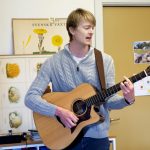Beneath icy waters: A research excursion to the Arctic
2021-07-14

photo: https://lnu.se/en/research/searchresearch/research-projects/project-arctic-expedition—synoptic-arctic-survey-sas-oden-2021/
In just two weeks, our team of picophytoplankton researchers will board the research SAS Oden and set sail on July 26, when the icebreaker departs from Helsingborg. On August 2, the observations in the Arctic Ocean begin. The estimated return to Helsingborg is September 20, 2021. Preparations for the excursion have been underway for over a year – the global pandemic in 2020 canceled the research trip last year, and the marine scientists have redoubled their efforts to ensure a sampling trip that is both COVID-safe and successful in its scientific conquests.
The study is part of the Synoptic Arctic Survey, an international study that will be making a comprehensive investigation of the current state of the Arctic ecosystem from 2020-2022 and assess how it is changing.
In the Swedish part of the survey, 39 researchers from 14 institutions will be participating. From Lnu, project managers Hanna Farnelid, Karin Holmfeldt, and Samuel Hylander lead their group.
For updates on this synoptic survey, you can visit the official blog: https://www.polar.se/en/news/?c=blog%20posts&t=synoptic%20arctic%20survey%202021 as well as the project page https://lnu.se/en/research/searchresearch/research-projects/project-arctic-expedition—synoptic-arctic-survey-sas-oden-2021/ .
Christien Laber, one of MPEA’s researchers is prepping for the excursion. Christien spend his time on the arctic investigating picophytoplankton, the smallest photosynthesizing organisms on the planet, and their contribution to sustaining the marine ecosystem in the Arctic. He will begin his journey by undertaking a quarantine in Malmö beginning July 16th:
What has been the biggest challenge in preparing for your trip to the Arctic?
Two things. Details, and shortages due to coronavirus. Details are very important because we will be at sea for two months. If we forget anything or don’t have spares when things break, there’s no way to get extras. So we really have to plan all of our experiments and the things we need for them very carefully. This has been a bit more difficult recently with coronavirus as well, because some equipment we buy well ahead of time takes a long time to get here, which makes it difficult to feel prepared when we never know when equipment will show up.
What is your schedule like from day to day?
Every day will be different. We have a number of experiments we will conduct and they will be done at different times throughout the cruise. We also have a number of core sampling procedures we will do every day, but may have different personnel doing them depending on the other tasks that are ongoing. But one thing that will remain the same is that there will be lots of filtering seawater, every single day.
You work with Hanna Farnelid and her team on the picophytoplankton research. What kind of sampling will you do and equipment you will use to answer your research questions?
We will be doing experiments to investigate how the smallest phytoplankton in the arctic grow, what types of nutrients they consume, and then in turn how quickly they are eaten by larger plankton. Our deck-board incubators are important for conducting these studies, as it allows us see what happens in the seawater over time. Because water is always moving, we can’t simply sample the ocean over three days and expect it to be the same water, so these incubators allow us to know we are working with the same water over each of our experiment time points.
We will surely miss you all and look forward to seeing you! We know that updates from the vessel will be few and far between, if at all, but we look forward to seeing the samples, and the photos, upon your return!
-Caroline Littlefield

 What is your background as a marine biologist and researcher?
What is your background as a marine biologist and researcher?  An interview with Christien Laber:
An interview with Christien Laber: Register to “A conscious focus on unconscious bias”
Register to “A conscious focus on unconscious bias” Dr. Eva Sörenson defended her thesis on September 25th , 2020.
Dr. Eva Sörenson defended her thesis on September 25th , 2020. 




